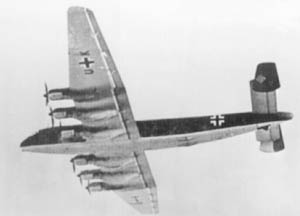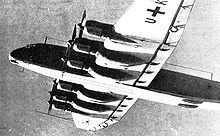Junkers Ju 390 Video - World War II pictures
|
|
Junkers Ju 390
Ju 390

Picture - Junkers Ju 390 V1
Role: Long range transport/maritime reconnaissance/bomber
Manufacturer: Junkers
First flight: 20 October 1943
Introduced: 1943
Retired: 1945
Primaryuser: Luftwaffe
Number built: 2
Developed from: Junkers Ju 290
The Junkers Ju 390 was a German aircraft intended to be used as a heavy transport, maritime patrol aircraft, and long-range bomber, a long-range derivative of the Ju 290. It was one of the aircraft (along with the Messerschmitt Me 264 and Focke-Wulf Ta 400) submitted for the abortive Amerika Bomber project.
Design and development

Picture - Junkers Ju 390 V1 in flight.
Two prototypes were created by attaching an extra pair of inner-wing segments onto the wings of basic Ju 90 and Ju 290 airframes, and adding new sections to lengthen the fuselages.
The first prototype, the V1, (bearing Stammkennzeichen code of GH+UK), was modified from a Ju 90V6 airframe (werke number J4918, civil registration D-AOKD) from July 1940 to April 1941, then to the Luftwaffe as KH+XC, from April 1941 through April 1942, then returned to Junkers and used for Ju 390 V1 construction). It made its maiden flight on 20 October 1943 and performed well, resulting in an order for 26 aircraft, to be designated Ju 390 A-1. None of these were actually built by the time that the project was cancelled (along with Ju 290 production) in mid-1944.
The second prototype, the V2 (RC+DA), was longer than the V1 because it was constructed from a Ju 290 airframe (using the fuselage of Ju 290A1 werke number J900155).
The maritime reconnaissance and long-range bomber versions were to be designated the Ju 390 B and Ju 390 C, respectively. It has been suggested that the bomber could have carried the Messerschmitt Me 328 parasite fighter for self-defense, and some test flights are believed to have been performed by a Ju 390 prototype equipped with the anti-shipping Fritz X guided glide bomb.
Operational history
V1
The V1 was constructed and largely assembled at Junkers' plant at Dessau, Germany, and the first test flight took place on 20 October 1943. Its performance was satisfactory enough that the Air Ministry ordered 26 in addition to the two prototypes. However, the contracts for the 26 Ju 390s were cancelled in June 1944 and all work ceased in September of that year.
On 26 November 1943, the Ju 390V1 - with many other new aircraft and prototypes - was shown to Adolf Hitler at Insterburg, East Prussia.
According to former Junkers test pilot Hans-Joachim Pancherz' logbook, the Ju 390V1 was brought to Prague immediately after it had been displayed at Insterburg, and while there took part in a number of test flights, which continued until March 1944, including tests of inflight refueling.
The Ju 390V1 was returned to Dessau in November 1944, where it was stripped of parts and finally destroyed in late April 1945 as the American Army approached.
V2
The Ju 390 V2 was assembled in Bernburg, was first flown in October 1943, and is said to have been configured for the maritime reconnaissance role. Its fuselage had been extended by 2.5m (8.2 ft), and it was equipped with FuG 200 Hohentwiel ASV (Air to Surface Vessel) radar and defensive armament consisting of five 20mm MG 151/20 cannon. Green notes different armament, specifically four 20mm MG 151/20s and three 13mm (.51in) MG 131 machine guns.
Test pilot Oberleutnant Eisermann recorded in his logbook that he flew the V2 prototype (RC+DA) as late as February 1945. However, Kx¶ssler and Ott state that the Ju 390V2 was only completed during June 1944, with flight tests beginning at the end of September 1944.
A Ju 390, which may or may not have been the V2, is claimed by some to have made a test flight from Germany to Cape Town in early 1944. The sole source for the story is a speculative article which appeared in the Daily Telegraph in 1969 titled Lone Bomber Raid on New York Planned by Hitler, in which Hans Pancherz reportedly claimed to have made the flight in question. Author James P. Duffy has carried out extensive research into this claim, which has proved fruitless. Kx¶ssler and Ott make no mention of this claim either, despite having themselves interviewed Pancherz.
New York flight
The first public mention of an alleged flight of a Ju 390 to North America appeared in the 11 November 1955 issue of the British magazine RAF Flying Review, of which aviation writer William Green was an editor. The magazine's editors were skeptical of the claim, which asserted that two Ju 390s had made the flight, though in March 1956, they published a letter from a reader which claimed to clarify the account. This letter stated that a single aircraft had made the flight and that it had reached a point about 19km (12 mi) off the US east coast, just north of NYC.
According to Green's reporting, in June 1944, Allied Intelligence had learned from prisoner interrogations that a Ju 390 had been delivered in January 1944 to FAGr 5 (Fernaufklx¤rungsgruppe 5), based at Mont-de-Marsan near Bordeaux, and that it had completed a 32-hour reconnaissance flight to within 19km (12 mi) of the US coast, north of New York City. This was, however, rejected just after the war by British authorities. Aviation historian Dr. Kenneth P. Werrell states that the story of the flight originated in two British intelligence reports from August 1944 which were based in part on the interrogation of prisoners, and titled General Report on Aircraft Engines and Aircraft Equipment; the reports claimed that the Ju 390 had taken photographs of the coast of Long Island. These photos have never been discovered.
The claimed flight was mentioned in many books following the RAF Flying Review account, including William Green's own respected Warplanes of the Second World War (1968) and Warplanes of the Third Reich (1970) but without ever citing reliable sources. Further authors then cited Green's books as their source for the claimed flight. Green himself told Kenneth P. Werrell many years later that he no longer placed much credence in the flight.
Werrell himself later examined the available data regarding the Ju 390's range and concluded that although a great circle round trip from France to St. Johns, Newfoundland was possible, adding another 3,830km (2,380 mi) for a round trip from St. Johns to Long Island made the flight "most unlikely".
Karl Kx¶ssler and Gx¼nter Ott, in their book Die groxŸen Dessauer: Junkers Ju 89, 90, 290, 390. Die Geschichte einer Flugzeugfamilie ("Great Dessauers...History of an Aircraft Family"), also examined the claimed flight, and thoroughly debunked the flight north of New York. Most importantly, it was nowhere near France at the time when the flight was supposed to have taken place. According to Hans Pancherz' logbook, the Ju 390V1 was brought to Prague on 26 November 1943. While there, it took part in a number of test flights, which continued until late March 1944. Secondly, they also assert that the Ju 390V1 prototype was unlikely to have been capable of taking off with the fuel load necessary for a flight of such duration due to strength concerns caused by its modified structure; it would have required a takeoff weight of 65tonnes (72tons), while the maximum takeoff weight during its trials had been 34tonnes (38tons). According to Kx¶ssler and Ott, the Ju 390V2 could not have made the US flight either, since they indicate that it was not completed before September/October 1944.
Ju 390 export to Japan
Design work was carried out on a bomber-reconnaissance version of the aircraft. Considerable interest was displayed in this ultra-long range aircraft by the Imperial Japanese Army Air Force. In the autumn of 1944, the Japanese government acquired a manufacturing license for the Ju 390A-1. Under the licensing agreement, detailed manufacturing drawings were scheduled to be handed over to the Imperial Japanese Army's representative, Major-General Otani, by February 28, 1945.
There is no record of this part of the agreement having been fulfilled. No reference can be found to this Major General Otani mentioned by Russian historians, however ULTRA decrypts of diplomatic signals from Japan's embassy in Berlin concerning the voyage of Japanese submarine I-52 refer to a General Kotani in Germany requiring return passage in connection with transport back to Japan. These same signals refer to other passengers with higher priority.
Variants
Ju 390 V1 First prototype. Ju 390 V2 Second prototype. Ju 390 A-1 Planned heavy transport version. Ju 390 B Planned maritime patrol version. Ju 390 C Planned long-range heavy bomber version.
Operators
Germany
Luftwaffe
Fernaufklx¤rungsgruppe 5
Specifications (Ju 390 V1)
Picture -
Data from
General characteristics
Crew: 10
Length: 34.20 m (112 ft 2 in)
Wingspan: 50.30 m (165 ft 1 in)
Height: 6.89 m (22 ft 7 in)
Wing area: 254 m² (2,730 ft²)
Empty weight: 39,500 kg (87,100 lb)
Loaded weight: 53,112 kg (117,092 lb)
Max takeoff weight: 75,500 kg (166,400 lb)
Powerplant: 6x— BMW 801D radial engines, 1,272 kW (1,730 hp) each
Performance
Maximum speed: 505 km/h (314 mph)
Range: 9,700 km (6,030 mi)
Service ceiling: 6,000 m (19,700 ft)
Wing loading: 209 kg/m² (42.8 lb/ft²)
Power/mass: 0.17 kW/kg (0.10 hp/lb)
Armament
Guns: ** 2 x— 20 mm MG 151/20 cannons in dorsal turrets
1 x— 20 mm MG 151/20 in tail
2 x— 13 mm (.51 in) MG 131 machine guns at waist
2 x— 13 mm (.51 in) MG 131s in gondola
Related development
Junkers Ju 89
Junkers Ju 90
Junkers Ju 290
Comparable aircraft
Boeing B-29 Superfortress
Daimler Benz Project A
Daimler Benz Project B
Daimler Benz Project C
Focke-Wulf Ta 400
Messerschmitt Me 264
Nakajima G8N
Nakajima G10N
Bibliography
Duffy, James P. Target America: Hitler's Plan to Attack the United States. Santa Barbara, California: Greenwood Publishing Group, 2004. ISBN 0-27596-684-4.
Green, William. Warplanes of the Third Reich. London: Macdonald and Jane's Publishers Ltd., 1970. ISBN 0-356-02382-6.
Griehl, Manfred and Joachim Dressel. Heinkel: He 177, 277, 274. London: Stackpole Books, 1998. p. 191. ISBN 1-85310-364-0.
Nowarra, Heinz J. Junkers Ju 290, Ju 390 etc.. Atglen, PA: Schiffer Military History, 1997. ISBN 0-7643-0297-3.
Speer, Albert. Inside the Third Reich. New York: Simon & Schuster, 1997. ISBN 978-0684829494.
Staerck, Christopher, Paul Sinnott and Anton Gill. Luftwaffe: The Allied Intelligence Files. London: Brassey's, 2002. ISBN 1-57488-387-9.
Living Warbirds: The best warbirds DVD series.
Source: WikiPedia